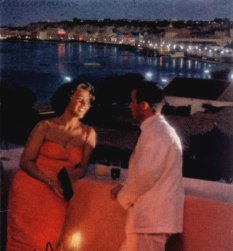

the lounge
The Anita Kerr SingersImagine The Free Design as an older-but-wiser combo, and you get a good idea of what the Anita Kerr Singers are like, at least when at their best. Anita Kerr must be one of the music industry's busiest and most versatile figures of the last 50 years, doing countless arrangements for television and records, from country & western to jazz to easy listening to inspirational genres. Not only a painstaking perfectionist on the other side of the studio glass, she is also a fine pianist and has a pure, bell-like soprano voice. These talents were put to their best use in some of the records she led during the mid-to-late 1960s. Her vocal group was comprised of herself with an alto and two baritones; their close harmonies can be breathtakingly effective. Arrangements are always tight and understated. Probably her best outing is 1960s "Sounds" for Warner Bros./Seven Arts. On cuts like "Happiness", "Say You Do" and "I'm Falling in Love Again", things swing along in a charming groove; the solo vocal songs can be a bit draggy. Not all of Anita Kerr's projects are worth picking up (take particular care to avoid the audio Valium that is the "Georgia on my Mind" LP), but "We Dig Mancini" and "…Reflect on the Hits of Burt Bacharach…" are studded with little gems. Claus OgermanIf you've listened to much in the way of Bossa Nova, you've probably heard the work of Claus Ogerman - arranger, conductor and pianist. His style is instantly recognizable: spare orchestration, single note melodies picked out on the piano, sparkling brushwork on the hi-hat cymbal, a deft touch of strings here and there. If the wilder end of the Brazilian sound was defined by Os Mutantes, Ogerman held down the opposite, sophisticated end. The records he made in the '60s with Antonio Carlos Jobim ("No Tempo da Bossa Nova" and "Wave") are brilliant in their understatement. So good was his work that Eumir Deodato copied it entirely for the follow-up album to "Wave" -- "Tide" -- a few years later. Mike Sammes SingersWe know little about British singer/arranger/bandleader Mike Sammes and his group of four women and four men singers, but we dig this album, titled "Smooth"! Recorded in 1964 for EMI, the dozen tunes on this album are standards, but they can and do swing, in a restrained way. "This Could be the Start of Something Big" grooves along, as do "Something's Gotta Give" and - surprisingly - "Surrey with the Fringe on Top"! There's not a lot of jazziness in the delivery, but this disk is nonetheless a polished slab of easy listening. Nina & FrederikWhat a surprise! From looking at the covers of their albums and knowing nothing about them, you might think (as we did) that the attractive young Danish couple made cheerful folk-pop music. Who would've guessed…calypso?! Perhaps they were attempting to cash in on the popularity of fellow Scandinavian Thor Heyerdahl's exploits in the South Pacific, or the success of Harry Belafonte's calypso records, but a less-likely style could hardly be imagined for these two. Some of the songs cover familiar Belafonte territory, but the less-mannered, original tunes better suit Nina's contralto voice and Frederik's baritone. Nothing here is exceptional in itself, but it all comes off as charming and heartfelt paean to the simple life in the tropics, on the other side of the world. Chris HinzeWe do lots of digging through the record bins at thrift stores here in Holland, looking for stuff we've never seen in the thrift stores of the US. Mixed in with all of the dreadful '80s pop, Dutch organ or accordion music and cheesy baroque compilations, we occasionally find something interesting. Chris Hinze is such a find. He looks a bit odd - or at least distinctive, in a Heino sort of way, with a pageboy haircut and tinted glasses (and for a while, a goatee). Hinze is a flautist, composer and arranger who has been active in the record industry since at least the mid-'60s. He seems to be best known in western Europe, where he had some highly successful recordings of classical works, but he also managed to mix in some jazzy pop originals. "Chris Hinze Plays Bacharach" from 1973 is a fine take on The Master's compositions, and his 1972 soundtrack for the Dutch TV documentary "Digging up the Past" titled "Virgin Sacrifice" is excellent. Hinze walks the fine line between pop-jazz and library music with aplomb here. Beware, though - some of his later work is more New Age Muzak. Sergio Mendes & Brazil 66You'd have to have spent the last 35 years on Mars to not have heard the music of Sergio Mendes and his first, great group: Brazil '66. True, Mendes is still hard at work, but the less said about his post-1970 output, the better. But the first three albums were an excellent synthesis of genuine Brazilian musical trends and American pop sensibilities. The two main female vocalists - Lani Hall and Karen Philipp - have the sunniest of voices, and the male voices are adequate. The group covered a few too many well-known pop tunes, but they really shine on the more Brazilian numbers, such as the iconic "Mais Que Nada". Some of the English language pieces are excellent as well, particularly "Like a Lover" and "Pretty World". Mendes was a fine arranger, but turned pathologically commercial in later years, cranking out middle-of-the-road disco tripe. Unfortunately, as good as the early work can be, it tends to be packaged into rather uneven mixes with later stuff. the cabaña the space station the cabaret the jazz club the conservatory the concert hall the trip the screening room |